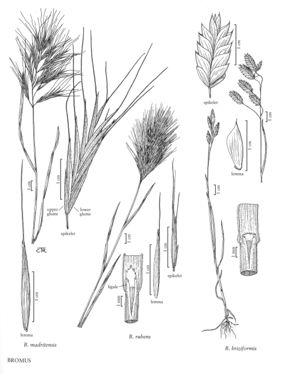Difference between revisions of "Bromus briziformis"
imported>Volume Importer |
imported>Volume Importer |
||
| Line 47: | Line 47: | ||
|publication year= | |publication year= | ||
|special status=Introduced | |special status=Introduced | ||
| − | |source xml=https:// | + | |source xml=https://bitbucket.org/aafc-mbb/fna-data-curation/src/2e0870ddd59836b60bcf96646a41e87ea5a5943a/coarse_grained_fna_xml/V24/V24_322.xml |
|subfamily=Poaceae subfam. Pooideae | |subfamily=Poaceae subfam. Pooideae | ||
|tribe=Poaceae tribe Bromeae | |tribe=Poaceae tribe Bromeae | ||
Revision as of 20:50, 5 November 2020
Plants annual. Culms 20-62 cm, erect or ascending. Sheaths densely pilose; ligules 0.5-2 mm, hairy, obtuse, erose; blades 3-13 cm long, 2-4 mm wide, pilose to pubescent on both surfaces. Panicles 5-15 cm long, 3-7 cm wide, open, secund, nodding; branches sometimes longer than the spikelets, curved to reflexed. Spikelets 15-27 mm long, 8-12 mm wide, ovate, laterally compressed; florets 7-15, bases concealed at maturity; rachilla internodes concealed at maturity. Glumes smooth or scabridulous; lower glumes 5-6 mm, 3-5-veined; upper glumes 6-8 mm, 7-9-veined; lemmas 9-10 mm long, 6-8 mm wide, inflated, obovate or rhombic, coriaceous, smooth or scabridulous, obscurely 9-veined, rounded over the midvein, margins hyaline, 1-1.3 mm wide, abruptly angled, not inrolled at maturity, apices acute to obtuse, bifid, teeth shorter than 1 mm; awns usually absent, sometimes to 1 mm, arising less than 1.5 mm below the lemma apices; anthers 0.7-1 mm. Caryopses equaling or shorter than the paleas, thin, weakly inrolled or flat. 2n = 14.
Distribution
Wash., Conn., Mass., Vt., Del., Idaho, Mont., Oreg., Wyo., N.J., N.Mex., N.Y., Pa., B.C., Ont., Calif., Nev., Colo., Alaska, Ill., Ind., N.Dak., Nebr., S.Dak., Md., Ohio, Utah, Mich.
Discussion
Bromus briziformis grows in waste places, road verges, and overgrazed areas. It is native to southwest Asia and Europe, and is adventive in the Flora region, occurring from southern British Columbia to as far south as New Mexico, and in scattered locations eastward. The unique shape of its spikelets has led to its use in dried flower arrangements and as a garden ornamental. The common name may refer to the similarity of the spikelets to a rattlesnake's tail.
Selected References
None.
